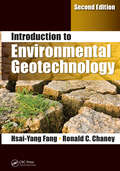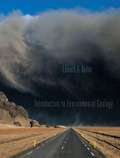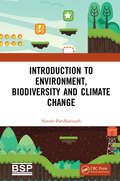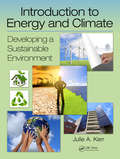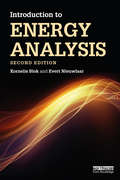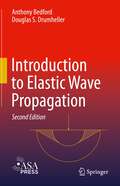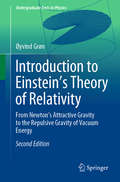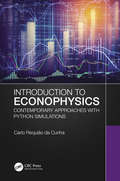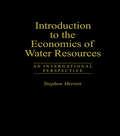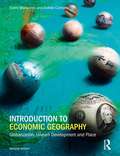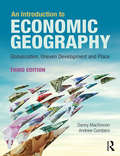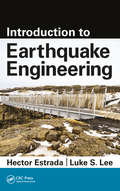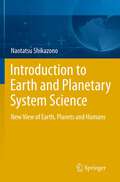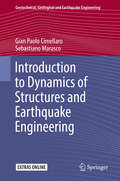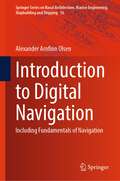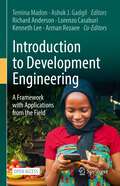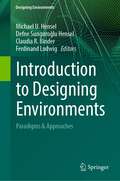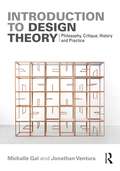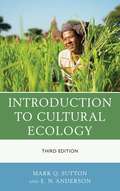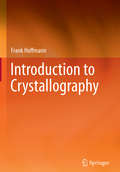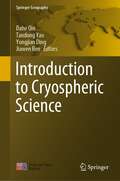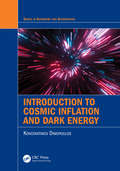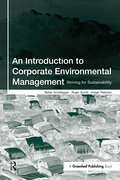- Table View
- List View
Introduction to Environmental Geotechnology
by Hsai-Yang Fang Ronald C. ChaneyThis new edition of a bestseller presents updated technology advances that have occurred since publication of the first edition. It increases the utility and scope of the content through numerous case studies and examples and an entirely new set of problems and solutions. The book also has an accompanying instructor's guide and presents rubrics by which instructors can increase student learning and evaluate student outcomes, chapter by chapter. The book focuses on the increasing importance of water resources and energy in the broader context of environmental sustainability. It’s interdisciplinary coverage includes soil science, physical chemistry, mineralogy, geology, ground pollution, and more.
Introduction to Environmental Geology Fifth Edition
by Edward A. KellerThis text focuses on helping non-science majors develop an understanding of how geology and humanity interact. Ed Keller--the author who first defined the environmental geology curriculum--focuses on five fundamental concepts of environmental geology: Human Population Growth, Sustainability, Earth as a System, Hazardous Earth Processes, and Scientific Knowledge and Values. These concepts are introduced at the outset of the text, integrated throughout the text, and revisited at the end of each chapter. The Fifth Edition emphasizes currency, which is essential to this dynamic subject, and strengthens Keller's hallmark "Fundamental Concepts of Environmental Geology," unifying the text's diverse topics while applying the concepts to real-world examples.
Introduction to Environment, Biodiversity and Climate Change
by Navale PandharinathEnvironment includes air, water, land and the inter relationship between air water, land and human beings and other living creatures, plants micro-organisms and property. Environment effects the wellbeing of man, animal and plants world over. Man is more advanced in intellect and hence it is the duty of man to protect the environment from undesired pollutions. The book discusses various aspects of Global warming, climate change, health hazards, dwindling of forest, water resources and natural resources and stress on biological diversity.Note: T&F does not sell or distribute the Hardback in India, Pakistan, Nepal, Bhutan, Bangladesh and Sri Lanka.
Introduction to Energy and Climate: Developing a Sustainable Environment
by Julie KerrThe purpose of this textbook is to provide a well-rounded working knowledge of both climate change and environmental sustainability for a wide range of students. Students will learn core concepts and methods to analyze energy and environmental impacts; will understand what is changing the earth’s climate, and what that means for life on earth now and in the future. They will also have a firm understanding of what energy is and how it can be used. This text intends to develop working knowledge of these topics, with both technical and social implications. Students will find in one volume the integration and careful treatment of climate, energy, and sustainability.
Introduction to Energy Analysis
by Kornelis Blok Evert NieuwlaarThe energy supply and demand system is of great importance for society, from economic, social, and ecological viewpoints. The last decade in particular has seen rapid changes in the world of energy systems, and it is therefore now an important area for study, academic research, and professional work. This textbook provides an introduction to energy analysis for those students who want to specialise in this challenging field. In comparison to other textbooks, this book provides a balanced treatment of complete energy systems, covering the demand side, the supply side, and the energy markets that connect these. The emphasis is very much on presenting a range of tools and methodologies that will help students find their way in analysing real world problems in energy systems. Featuring learning objectives, further readings and practical exercises in each chapter, An Introduction to Energy Analysis will be essential reading for upper-level undergraduate and postgraduate students with a background in the natural sciences and egineering. This book may also be useful for professionals dealing with energy issues, as a first introduction into the field.
Introduction to Elastic Wave Propagation
by Anthony Bedford Douglas S. DrumhellerThis revised and updated edition expands on its explanations of methods used to analyze waves in solid materials, such as the waves created by earthquakes and the ultrasonic waves used to detect flaws in materials and for medical diagnoses. In addition to the traditional methods used to analyze steady-state and transient waves in elastic materials, the book contains introductions to advanced areas that no other single text covers. These topics include the use of finite elements to solve wave problems, the Cagniard-de Hoop method, the four-pole technique for analyzing waves in layered media, and the growth and decay of shock and acceleration waves. The authors explain the theory of linear elasticity through the displacement equations of motion, methods used to analyze steady-state and transient waves in layered media, and include an appendix on functions of a complex variable. Originally developed for a graduate course for which no suitable text existed, the new edition retains its classroom-tested treatment of the theories of linear elasticity and complex variables for students needing background in those subjects.
Introduction to Einstein’s Theory of Relativity: From Newton’s Attractive Gravity to the Repulsive Gravity of Vacuum Energy (Undergraduate Texts in Physics)
by Øyvind GrønThe revised and updated 2nd edition of this established textbook provides a self-contained introduction to the general theory of relativity, describing not only the physical principles and applications of the theory, but also the mathematics needed, in particular the calculus of differential forms.Updated throughout, the book contains more detailed explanations and extended discussions of several conceptual points, and strengthened mathematical deductions where required. It includes examples of work conducted in the ten years since the first edition of the book was published, for example the pedagogically helpful concept of a "river of space" and a more detailed discussion of how far the principle of relativity is contained in the general theory of relativity. Also presented is a discussion of the concept of the 'gravitational field' in Einstein's theory, and some new material concerning the 'twin paradox' in the theory of relativity. Finally, the book contains a new section about gravitational waves, exploring the dramatic progress in this field following the LIGO observations. Based on a long-established masters course, the book serves advanced undergraduate and graduate level students, and also provides a useful reference for researchers.
Introduction to Econophysics: Contemporary Approaches with Python Simulations
by Carlo Requião da CunhaEconophysics explores the parallels between physics and economics and is an exciting topic that is attracting increasing attention. However there is a lack of literature that explains the topic from a broad perspective. This book introduces advanced undergraduates and graduate students in physics and engineering to the topic from this outlook, and is accompanied by rigorous mathematics which ensures that this will also be a good guide for established researchers in the field as well as researchers from other fields, such as mathematics and statistics, who are interested in the topic. Key features: Presents a multidisciplinary approach that will be of interest to students and researchers from physics, engineering, mathematics, statistics, and other physical sciences Accompanied by Python code with further learning opportunities, available for readers to download from the CRC Press website. Accessible to both students and researchers Carlo R. da Cunha is an associate professor of physics and engineering physics at the Universidade Federal do Rio Grande do Sul (Brazil) and has been since 2011. Dr. da Cunha received his M.Sc. Degree from the West Virginia University in 2001 and his Ph.D. degree from Arizona State University in 2005. He was a postdoctoral researcher at McGill University in Canada in 2006 and an assistant professor of engineering at the University Federal de Santa Catarina between 2007 and 2011. He has been a guest professor at the Technische Universität Wien (Austria), Chiba University (Japan) and Arizona State University (US). His research revolves around the physics of complex systems where he has been drawing parallels between physical and economic systems from quantum to social levels.
Introduction To The Economics Of Water Resources: An International Perspective
by Stephen MerrettFirst published in 1997. Routledge is an imprint of Taylor & Francis, an informa company.
Introduction to Economic Geography: Globalization, Uneven Development and Place
by Andrew Cumbers Danny MackinnonToday's rapidly flowing global economy, hit by recession following the financial crisis of 2008/9, means the geographical economic perspective has never been more important. An Introduction to Economic Geography comprehensively guides you through the core issues and debates of this vibrant and exciting area, whilst also exploring the range of approaches and paradigms currently invigorating the wider discipline. Rigorous and accessible, the authors demystify and enliven a crucial subject for geographical study. Underpinned by the themes of globalisation, uneven development and place, the text explores the diversity and vitality of contemporary economic geography. It balances coverage of 'traditional' areas such as regional development and labour markets with insight into new and evolving topics like neoliberalism, consumption, creativity and alternative economic practices. An Introduction to Economic Geography is an essential textbook for undergraduate students taking courses in Economic Geography, Globalisation Studies and more broadly in Human Geography. It will also be of key interest to anyone in Planning, Business and Management Studies and Economics.
An Introduction to Economic Geography: Globalisation, Uneven Development and Place
by Andrew Cumbers Danny MacKinnonIn the context of great economic turmoil and uncertainty, the emergent conflict between continued globalisation and growing economic nationalism means that a geographical economic perspective has never been so important. An Introduction to Economic Geography guides students through the key debates of this vibrant area, exploring the range of ideas and approaches that invigorate the wider discipline. This third edition includes new chapters on finance, cities and the digital economy, consumption and the environment. Underpinned by the themes of globalisation, uneven development and place, the text conveys the diversity of contemporary economic geography and explores the social and spatial effects of global economic restructuring. It combines a critical geographical perspective on the changing economic landscape with an appreciation of contemporary themes such as neoliberalism, financialisation, innovation and the growth of new technologies. An Introduction to Economic Geography is an essential textbook for undergraduate students taking courses in Economic Geography, Globalisation Studies and more broadly in Human Geography. It will also be of much interest to those in Planning, Business and Management Studies and Economics.
Introduction to Earthquake Engineering
by Hector Estrada Luke S. LeeThis book is intended primarily as a textbook for students studying structural engineering. It covers three main areas in the analysis and design of structural systems subjected to seismic loading: basic seismology, basic structural dynamics, and code-based calculations used to determine seismic loads from an equivalent static method and a dynamics-based method. It provides students with the skills to determine seismic effects on structural systems, and is unique in that it combines the fundamentals of structural dynamics with the latest code specifications. Each chapter contains electronic resources: image galleries, PowerPoint presentations, a solutions manual, etc.
Introduction to Earth and Planetary System Science
by Naotatsu ShikazonoThis book presents basic information on material science (geochemistry, geophysics, geology, mineralogy, etc.), interaction between subsystem consisting earth system (atmosphere, hydrosphere, litho (geo) sphere, biosphere, humans) and in earth-planet system and evolution of earth-planetary system. The nature-humans interactions are described and new view on earth, planets and humans (integration of anthropocentrism and naturecentrism) are presented.
Introduction to Dynamics of Structures and Earthquake Engineering (Geotechnical, Geological And Earthquake Engineering Ser. #45)
by Gian Paolo Cimellaro Sebastiano MarascoThis work is an elementary but comprehensive textbook which provides the latest updates in the fields of Earthquake Engineering, Dynamics of Structures, Seismology and Seismic Design, introducing relevant new topics to the fields such as the Neodeterministic method. Its main purpose is to illustrate the application of energy methods and the analysis in the frequency domain with the corresponding visualization in the Gauss-Argant plan. However, emphasis is also given to the applications of numerical methods for the solution of the equation of motion and to the ground motion selection to be used in time history analysis of structures. As supplementary materials, this book provides “OPENSIGNAL", a rare and unique software for ground motion selection and processing that can be used by professionals to select the correct earthquake records that would run in the nonlinear analysis. The book contains clear illustrations and figures to describe the subject in an intuitive way. It uses simple language and terminology and the math is limited only to cases where it is essential to understand the physical meaning of the system. Therefore, it is suitable also for those readers who approach these subjects for the first time and who only have a basic understanding of mathematics (linear algebra) and static analysis of structures.
An Introduction to Dynamic Meteorology
by James R. HoltonThis revised text presents a cogent explanation of the fundamentals of meteorology, and explains storm dynamics for weather-oriented meteorologists. It discusses climate dynamics and the implications posed for global change. Formulas have been removed.
Introduction to Digital Navigation: Including Fundamentals of Navigation (Springer Series on Naval Architecture, Marine Engineering, Shipbuilding and Shipping #16)
by Alexander Arnfinn OlsenThis book focuses on Coastal and Ocean Navigation with an emphasis on digital navigation (using ECDIS) and would be useful to both experienced seafarers as an aide memoire, and also to cadets and trainees embarking on their maritime careers.The text has been developed for modern day ship’s navigator in the ‘digital era’. It is written from the perspective that the reader’s vessel will be navigated using an IMO type-approved electronic chart and display information system (ECDIS) as opposed to traditional chart-based passage planning. As such, the book focuses on the main principles associated with position and direction of the earth's surface, geodesy projects and grids, digital navigation, electronic chart and data information systems, fixing, internal aids to navigation and systems, external aids to navigation, tides and currents, ocean navigation, coastal navigation, pilotage and blind pilotage, anchoring, navigational errors, relative velocity, and bridge organisation and management.
Introduction to Development Engineering: A Framework with Applications from the Field
by Richard Anderson Kenneth Lee Temina Madon Ashok J. Gadgil Lorenzo Casaburi Arman RezaeeThis open access textbook introduces the emerging field of Development Engineering and its constituent theories, methods, and applications. It is both a teaching text for students and a resource for researchers and practitioners engaged in the design and scaling of technologies for low-resource communities. The scope is broad, ranging from the development of mobile applications for low-literacy users to hardware and software solutions for providing electricity and water in remote settings. It is also highly interdisciplinary, drawing on methods and theory from the social sciences as well as engineering and the natural sciences.The opening section reviews the history of “technology-for-development” research, and presents a framework that formalizes this body of work and begins its transformation into an academic discipline. It identifies common challenges in development and explains the book’s iterative approach of “innovation, implementation, evaluation, adaptation.” Each of the next six thematic sections focuses on a different sector: energy and environment; market performance; education and labor; water, sanitation and health; digital governance; and connectivity. These thematic sections contain case studies from landmark research that directly integrates engineering innovation with technically rigorous methods from the social sciences. Each case study describes the design, evaluation, and/or scaling of a technology in the field and follows a single form, with common elements and discussion questions, to create continuity and pedagogical consistency. Together, they highlight successful solutions to development challenges, while also analyzing the rarely discussed failures. The book concludes by reiterating the core principles of development engineering illustrated in the case studies, highlighting common challenges that engineers and scientists will face in designing technology interventions that sustainably accelerate economic development.Development Engineering provides, for the first time, a coherent intellectual framework for attacking the challenges of poverty and global climate change through the design of better technologies. It offers the rigorous discipline needed to channel the energy of a new generation of scientists and engineers toward advancing social justice and improved living conditions in low-resource communities around the world.
Introduction to Designing Environments: Paradigms & Approaches (Designing Environments)
by Michael U. Hensel Defne Sunguroğlu Hensel Claudia R. Binder Ferdinand LudwigThe Designing Environments book series addresses questions regarding necessary environmental transformation in the context of the fast-unfolding environmental crisis. This is done from a broad interdisciplinary perspective, examining the negative impact of human transformations of the environment and providing different inroads towards sustainable environmental transformation with net positive impact.Volume one of the Designing Environments book series brings together experts from different disciplines and often inter- and transdisciplinary contexts, who discuss specific approaches to overcoming the negative impact of the transformation of environments by humans. Across the 12 chapters of volume one, specific keywords recur that are indicative of shared insights and concerns. These include Anthropocene, climate change, complexity, critical zone, ecosystem services, and sustainability. Furthermore, interdisciplinary approaches to human–environment interactions, sustainability transitions, and socio-ecological systems take center stage and are discussed in relation to conceptual and methodological as well as societal and technological challenges and opportunities.
Introduction to Design Theory: Philosophy, Critique, History and Practice
by Michalle Gal Jonathan VenturaIntroduction to Design Theory introduces a comprehensive, systematic, and didactic outline of the discourse of design. Designed both as a course book and a source for research, this textbook methodically covers the central concepts of design theory, definitions of design, its historical milestones, and its relations to culture, industry, body, ecology, language, society, gender and ideology. Demonstrated by a shift towards the importance of the sociocultural context in which products are manufactured and embedded, this book showcases design theory as an emerging sub-discipline of design, unique in its practice-based approach and its broad perception of design. It offers an in-depth understanding of the central concepts, such as "form" and "function", "theory" and "practice", through a discussion of key case studies and historical examples, such as the advent of the view of design in antiquity, the introduction of mass production to modernist design or the ideological shifts in design in the mid-twentieth century, as well as analytical tools for further dissection and learning in practice. With a focus on a combination of several theoretical knowledge foundations — aesthetics and philosophy, critical theories, cultural studies, design history and design anthropology — the reader is enabled to approach design as a central pivot around which contemporary culture revolves, reflecting, reaffirming or challenging social and cultural structures. Aimed towards undergraduate and postgraduate students, as well as teachers and scholars, from across the design disciplines, Introduction to Design Theory invites readers to engage with design from an interdisciplinary perspective, departing from the traditional academic compartmentalisation of practice, history and philosophy.
Introduction to Cultural Ecology
by Mark Q. Sutton; E. N. AndersonIntroduction to Cultural Ecology, Third Edition, familiarizes students with the foundations of the field and provides a framework for exploring what other cultures can teach us about human/environment relationships. Drawing on both biological and cultural approaches, the authors first cover basic principles of cultural anthropology, environmental studies, and human biological adaptations to the environment.
Introduction to Crystallography
by Frank HoffmannThis book invites you on a systematic tour through the fascinating world of crystals and their symmetries. The reader will gain an understanding of the symmetry of external crystal forms (morphology) and become acquainted with all the symmetry elements needed to classify and describe crystal structures. The book explains the context in a very vivid, non-mathematical way and captivates with clear, high-quality illustrations. Online materials accompany the book; including 3D models the reader can explore on screen to aid in the spatial understanding of the structure of crystals. After reading the book, you will not only know what a space group is and how to read the International Tables for Crystallography, but will also be able to interpret crystallographic specifications in specialist publications. If questions remain, you also have the opportunity to ask the author on the book's website.
Introduction to Cryospheric Science (Springer Geography)
by Dahe Qin Tandong Yao Yongjian Ding Jiawen RenThis book introduces systematically the cryospheric science, covering the formation, development, evolution, and research methods of each component of the cryosphere, the interaction between the cryosphere and the other spheres of the climate system and the anthroposphere, and the hot topics of social and economic sustainable development and geopolitics. The authors are world-renowned experts and scientists working in the related fields. They have a deep understanding and accurate grasp of the basic theory, evolution mechanism, and international frontiers of the cryosphere, as well as rich teaching experience, which makes this book suitable also as textbook for graduate students. It is also the first book that introduces the knowledge of cryospheric science systematically. In addition to theoretical knowledge, the book also introduces field work and experimental analysis. It should be of interests for the scholars and graduate student working in the fields of geography, hydrology, geology, geomorphology, atmosphere, ecology, environment, oceanography, and regional economic and social sustainable development.
Introduction to Cosmic Inflation and Dark Energy (ISSN)
by Konstantinos DimopoulosCosmic inflation and dark energy hold the key to the origin and the eventual fate of the Universe. Despite the increasing prominence of these subjects in research and teaching over the past decade or more, no introductory textbook dedicated to these topics has been previously published. Dr. Konstantinos Dimopoulos is a highly regarded expert in the field, and an experienced communicator of the subject to students. In this book, he provides advanced undergraduate and early graduate students with an accessible introduction and equips them with the tools they need to understand the cosmology of cosmic inflation and dark energy.Features: Provides a concise, pedagogical "crash course" in big bang cosmology, focusing on the dynamics and the history of the Universe, with an emphasis on the role of dark energy Chapters contain questions and problems for readers to test their understanding The first book to make cosmic inflation and dark energy accessible to students
An Introduction to Corporate Environmental Management: Striving for Sustainability
by Stefan Schaltegger Roger Burritt Holger PetersenThis book is designed to meet the urgent need for a comprehensive and definitive introduction and teaching text on corporate environmental management. It aims to become the standard textbook for courses examining how business can take the environment into account while also providing an accessible and thorough overview of this increasingly multidisciplinary subject for practitioners.Written by the internationally acknowledged experts Stefan Schaltegger and Roger Burritt (authors of the highly influential Contemporary Environmental Accounting) along with Holger Petersen, the book invites the reader to join in an exploration of the ways in which companies can engage in environmental management and why such engagement can be profitable for business. The reader is invited to: examine whether the contents reflect their own experience, takes their experience further, or opposes their own views; note which of the ideas presented are especially important, add to those ideas, or encourage a reaction (positive or negative); answer questions creatively (based on their own perspective of the issues); encourage themselves to be inspired by questions, which can be investigated further through other written sources of information, such as books you will be guided to through the bibliography, the Internet or the general media; and think about and plan the ways in which the knowledge provided can be implemented in your own situation.The book is organised into four main sections. First, the fundamental ideas and linkages behind business management, the environment and sustainable development are briefly but clearly sketched. The second part of the book outlines the criteria against which environmentally oriented business management can be assessed and the fields of action in which success can be achieved. The third part presents a discussion and examples of strategies for environmental management, which are linked, in the fourth part, to the essential tools of environmental management, especially green marketing, environmental accounting and eco-control.The book is full of case studies and examples related to the main contents of each chapter and each chapter provides a number of questions for the student or reader to address.An Introduction to Corporate Environmental Management is both a textbook and a sourcebook. The reader can either work through the material in a structured way or dip into the content and follow up on specific areas of interest. The materials are designed to be used for understanding and reference, rather than to be learned by heart. The primary aim is for the reader to obtain a practical understanding of the relationship between management and environmental issues which can be applied in day-to-day situations-whether as part of a student's wider view of management or within the practitioner's real-world situation. It will be essential reading for many years to come.
Introduction to Controlled-Source Electromagnetic Methods: Detecting Subsurface Fluids
by Anton Ziolkowski Evert SlobThis volume describes how controlled-source electromagnetic (CSEM) methods are used to determine the electrical conductivity and hydrocarbon content of the upper few kilometres of the Earth, on land and at sea. The authors show how the signal-to-noise ratio of the measured data may be maximised via suitable choice of acquisition and processing parameters and selection of subsequent data analysis procedures. Complete impulse responses for every electric and magnetic source and receiver configuration are derived, providing a guide to the expected response for real data. 1-D, 2-D and 3-D modelling and inversion procedures for recovery of Earth conductivity are presented, emphasising the importance of updating model parameters using complementary geophysical data and rock physics relations. Requiring no specialist prior knowledge of electromagnetic theory, and providing a step-by-step guide through the necessary mathematics, this book provides an accessible introduction for advanced students, researchers and industry practitioners in exploration geoscience and petroleum engineering.
